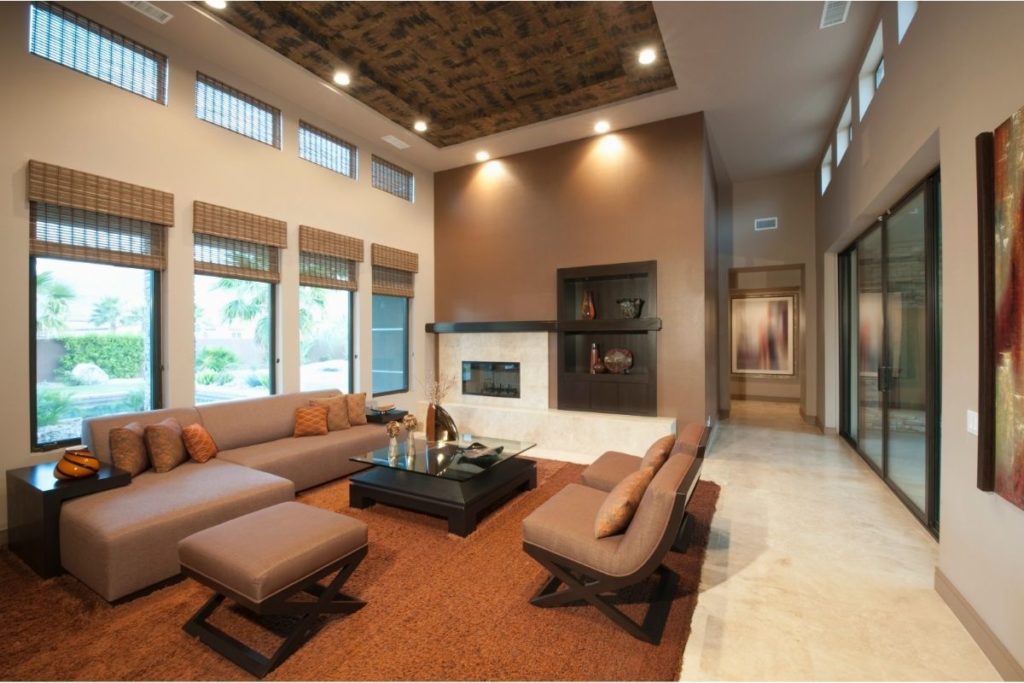You may be looking to install a ceiling fan or you might want to place a tall piece of furniture. For this, you will need to know your ceiling’s height to ensure you can fit it all in.
When a residential home is already in the planning stages, ceiling height usually isn’t a big discussion point but it definitely should be as it determines how spacious your home feels.
Lower ceilings can give you this sense of coziness and warmth. However, they can also feel cramped and allow you only to place certain types of furniture.
On the other hand, high ceilings feel inviting and open to us. With high ceilings typically used in older homes, it can give you a sense of elegance, grandeur, and openness.
However, no ceiling is the same but you can get a rough understanding from the standard ceiling height used in residential homes.
We take a look at different ceiling heights, how they are decided and how they can affect your living space.

What Is A Ceiling Height?
Ceiling height is the distance between the floor and the bottom of your home’s roof. The measurement starts from the top of the floorboards to the bottom of the roof slab. The standard ceiling height in a house varies depending on many different factors.
However, there is a minimum ceiling size and height in place for each room (see below) in a house to ensure that different types of rooms have enough light and are ventilated sufficiently. Standard ceiling heights can also vary by country or state, depending on local building preferences and building laws or regulations.
If there are no specific rules in place for average ceiling heights, then developers and contractors typically choose to keep the square feet of the rooms and ceilings comfortably small to get the best value out of the building project.
In the US, building by-law allows the right construction of dwellings with a standard floor height for residential buildings. This utilizes space and land as efficiently as possible.
Different Types Of Ceilings And Ceiling Heights
Let’s take a closer look now at the different types of ceilings and heights available to you!
Flat Ceilings
This is the most common ceiling type found in a residential home, and it is between 8 and 9 feet. The clue is in the name. Flat ceilings are flat and can be easily accessed. There are no further decorative features or anything particular about flat ceilings.
Due to the way they are constructed, flat ceilings can be difficult and expensive to raise, so it’s best to decide upfront if you are comfortable with the 8 or 9 feet standard ceiling height before you start building.
Tray Ceilings
Tray ceilings are around 9 feet tall around the edges and their center section is typically extending to up to 10 feet. These types of ceilings are only suitable for larger spaces in a big home as they will add a sense of elegance to the house.
Cathedral Ceilings
As the name suggests, a cathedral ceiling has been inspired by the construction style of cathedrals. This means they commonly feature sunken squares or rectangular panels to create a sense of additional height.
With a ceiling height of up to 13 feet, you can also often find them in vaulted ceilings where they create an impressive visual effect. This ceiling type also lends itself to work with exposed wooden beams, large chandeliers, or skylights which can add a special touch of individual design to a living space.
Coffered Ceilings
Coffered ceilings are the most impressive ceiling type. Although they are flat, they create a three-dimensional design with grooved wood panels arranged in a checkered pattern. This adds a visual feeling of space and openness.
Coffered ceilings must be a minimum of 9 feet tall to create the right effect. As coffered ceilings are very individual to your taste and your home, they need to be designed and installed by an experienced carpenter.
How Is A Ceiling’s Height Determined?
Deciding the minimum ceiling height for a residential building project usually depends on how the contractor wants to use the space. In the US, the requirements for a home’s minimum ceiling height are set by the International Residential Code (IRC).
For this reason, most residential buildings in America are based on the IRC’s building standards. Calculating ceiling height is quite simple. If you take your height, add on the rest of the length to get to the ceiling, and add around 2.5 feet, you then get the ideal ceiling height for yourself.
The IRC has used the standard height for an American adult and found that the minimum standard ceiling height, therefore, is between 8 and 9 feet. There are of course a few exceptions that the IRC code allows for. Spaces such as basements, laundry rooms, and entryways are recommended to be no less than 7 feet.
The code also considers the room’s specific fixtures, such as bathtubs or showers in the bathroom. These areas should be around 30 by 30 inches, with the showerhead being at a height of 6 foot 8 inches.

Standard Ceiling Heights By Room
We already mentioned that the standard minimum ceiling height varies by room. The IRC provides guidance and regulations for each room. It takes into account that closets, bathrooms, and hallways can have lower ceilings than where we spend most of our time, like living rooms and bedrooms.
These are basic minimum requirements for the best living quality, so any ceiling height that goes over the recommended ceiling height is a plus (depending on architectural style). Sometimes you find that entryways have much taller ceilings where they can reach almost twice the height of the recommended minimum.
Living spaces also typically have high ceilings, at times reaching up to 18 feet. This depends very much on the type and style of the house. Bear in mind that the type of ceiling in each room can also make a big difference.
For example, you will likely not have a vaulted ceiling in your five square feet bathroom because it simply doesn’t feel right. Whereas the kitchen as a commonly larger space may have a coffered ceiling with sunken panels for an added sense of space.
The IRC also has a standard for different ceiling types. For example, for sloped ceilings, the IRC code requires a minimum of 7 feet ceiling height across 50% of the room. The rest of the ceiling should not be lower than 5 feet.
This means that a standard attic ceiling should be a minimum of 5 feet tall in at least 50 percent of the room. As the size of a room is determined by its square footage, any ceilings lower than 5 feet would not count as official space, which would be inefficient space use for building developers.
The IRC’s building standards also put down some other rules, e.g. it says that in dwellings with single or multiple families, wooden beams cannot be spaced less than 4 feet apart. The beams also shouldn’t protrude more than 6 inches out of the ceiling.
Standard Ceiling Height For Commercial Buildings
Under the IRC code, commercial buildings and multifamily buildings (with more than two families) are very similar, and that’s why they share building regulations. The standard ceiling height for commercial buildings and multiple-family homes is 7 feet 6 inches.
This rule applies to all rooms in the building, including any common areas and hallways. Another authority that oversees building standards is the General Services Administration (GSA) which sets ceiling height standards for commercial buildings leased for the federal government.
The GSA specifies that office space should have a minimum ceiling height of 9 feet if the space is larger than 150 square feet. For a smaller office, the ceiling height should be at least 8 feet. Any other small areas, such as closets and toilets need to be 7 feet 6 inches from floor to ceiling.
Interestingly, large halls and rooms with video conferencing facilities need to have a ceiling that’s 10 feet tall. For any rooms that house mechanical equipment, the standard ceiling height is a minimum of 12 feet.
Choosing The Right Ceiling Height For A House
Choosing the right ceiling for your home depends on a couple of important factors. Most of the room size. Smaller rooms benefit from a flat ceiling with a minimum of 9 feet, whereas larger rooms with a coffered ceiling or tray ceiling can create a feeling of openness.
If you have a flat ceiling in one of your rooms and you want to change it into a tray-type ceiling, then you need to consider your existing ceiling height. For a tray ceiling, you need at least 8 feet to fit the drop-down borders or the checkerboard pattern.
If you are looking to extend your 9-foot ceiling, it’s a good idea to add a foot to give you a little more comfort and space. If you prefer a much taller ceiling, then you may want to consider 10-12 foot dimensions to give you additional wall space.

Vaulted ceilings are a great option to create a larger space. This sloped ceiling type needs to be at least 13 feet. The additional space allows you much more flexibility. For example, you could add exposed wooden beams and hang a glass chandelier making it an impressive centerpiece.
We recommend that you consider the size of the room together with the inside wall space if you want to create a two-story ceiling. Bear in mind that the typical height of these ceilings is up to 18 feet so there is a lot of space to fill.
You will typically find this ceiling type in condominiums and more modern home designs. For a two-story ceiling, the first-floor ceiling height should be 9 feet and the second story can be up to 8 feet. This gives you one-foot spare floor space.
It’s worthwhile mentioning here that the taller your ceiling, the higher your energy costs. As heat rises, the warmth drifts up towards the roof so it takes a lot of heating to get a big space warm.
This depends very much on where you live. If you live in a climate where it’s relatively mild and warm all year round, then tall ceilings are an option.
Conclusion
There are very good reasons why standard ceiling heights exist. It’s not just to comfortably enter a room without having to bend over, but a minimum 8 feet tall ceiling allows for much better ventilation and light in a room.
Of course, raising a ceiling is typically always possible, depending on the costs and structure of your home. Just bear in mind that taller ceilings do come with an added premium of having to heat a larger space, which leads to higher energy costs.
Overall, creating a large open space with tall ceilings can be a truly liberating feeling, and give your home more breathing space.
- Benjamin Moore Palladian Blue Paint: A Color Review - September 5, 2023
- 10 Of The Prettiest Interior Door Colors - August 29, 2023
- Hale Navy: The Best Navy Paint Color - August 22, 2023

![How To Design A Room Like An Interior Designer [Step By Step] ow To Design A Room Like An Interior Designer [Step By Step]](https://alexanderandpearl.co.uk/wp-content/uploads/2022/02/How-Much-Does-A-Pop-Up-Camper-Weigh-33.jpg)






